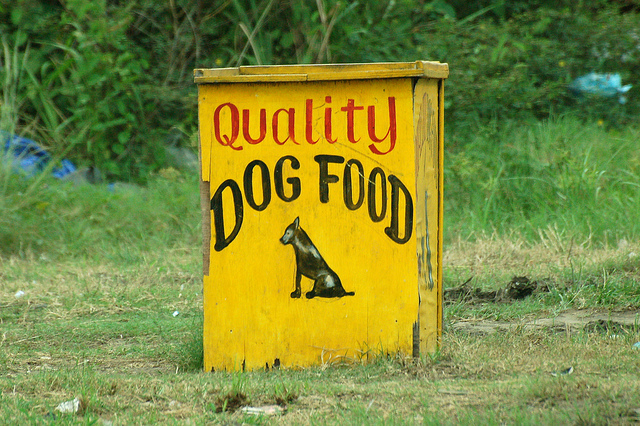A chubby puppy is not always a healthy puppy, especially in larger breeds. To make sure your puppy stays healthy it is important to keep their growth slow and steady. A large dog is one that will be over 55 pounds by the time they are full grown at about 2 years of age.
Below are some reasons on why keeping your puppies growth optimal will lead to a healthier and longer life:
Serious Health Problems Often Develop in Puppies Who Grow Too Fast – There are several factors that contribute to the skeletal development of puppies, including genetics, exercise, trauma and nutrition. One of the most important factors is nutrition. A number of orthopedic diseases, which are problems with a dog’s bones, joints, tendons, muscles and nerves, take root in poor feeding practices during the puppy’s growth period. These diseases include osteochondrosis, some forms of hip dysplasia, hypertrophic osteodystrophy and Wobbler’s syndrome. When a puppy’s body gets too big, too fast and gains a lot of weight, it puts stress on the developing skeleton. Rapid bone growth can result in structural defects of the bones, which makes the skeleton even less able to bear the increasing body weight.
Diet Influences How Fast a Puppy Grows – It Does Not Influence His Adult Size – Overfeeding an adult dog leads to obesity and serious health conditions like diabetes and heart disease. Overfeeding a puppy during the active, rapid growth period right after weaning leads to skeletal problems.
Protein is Not the Culprit — Excess Calories and Minerals Are – Researchers have studied the diets of large breed dogs for over 30 years to understand the link between improper nutrition and skeletal problems. Studies have repeatedly concluded dietary protein levels have no effect on the development of skeletal problems in large and giant breed dogs. The elements of nutrition that have been scientifically proven to negatively impact skeletal development in puppies are excessive calories and high or unbalanced mineral content, specifically calcium and phosphorus.
Why Excess Mineral Content is a Problem – The bodies of puppies aren’t able to control or limit absorption of dietary calcium and certain other minerals. Absorption, of course, occurs through the intestines. The higher the calcium and mineral content of the diet, the greater the level of absorption and assimilation into the developing bone structure of the puppy. This can disturb the natural process of bone growth and result in lesions in the skeleton and joints. High mineral concentrations in the diet can quickly cause bone mineral changes that play into skeletal abnormalities in a growing puppy. These include hypertrophic osteodystrophy, also called HOD. This is a severely painful bone disease that affects multiple limbs and causes lameness. Also craniomandibular osteopathy, a disease that affects the bones of the skull, including the lower jaw.
The Right Type of Food for Your Large or Giant Breed Pup – The goal in feeding a large or giant breed puppy is to keep him lean, with controlled growth. A healthy, large or giant breed puppy will thrive on a portion-controlled, balanced, species-appropriate diet. You can feed a spot-on balanced homemade diet or an excellent quality commercially available food. These are typically diets lower in calorie density (the number of calories per cup or gram of food) than a regular puppy diet. They’re also usually lower in calcium on an energy basis. These are two very important factors for reducing too-rapid growth in big puppies. Some adult foods may also be low calorically, but often they have high calcium content on an energy basis, which is not what you want for a growing large or giant breed pup.
If you’re going to feed kibble to a large breed puppy, I recommend you look for special large breed puppy formulas or a formula that is “Approved for all life stages.” This means the food is appropriate for growing puppies or adult dogs. I do not recommend feeding a traditional (high growth) puppy food to large breed puppies.
How Much to Feed – Most vets and breeders agree puppies can be moved to adult foods between six and 10 months of age, depending on the breed, size, and current physical development. Several factors will play into the amount of food you feed your puppy. They include the dog’s age, current weight, anticipated adult weight, her breed, the environment she’s in (including the climate), and her activity level. Puppies eat much more for their weight than adult dogs, and young puppies actually eat quite a bit more than older puppies. Very young puppies should be fed three to four times a day, in fact, whereas older puppies often do well with twice-daily feedings.
Remember, you’ll need to continually monitor your puppy’s condition and activity level. Since puppy appetites go up and down depending on what growth phase they’re in, you’ll need to adjust the volume of food you feed your puppy and keep him at the appropriate weight throughout his growth period.
Always monitor your dogs energy and activity level to make sure you are not overfeeding or underfeeding them at the different puppy stages in their lives.
Do you have any more advice for large puppy owners on how to properly feed them so they don’t “overgrow”?




Leave a Reply